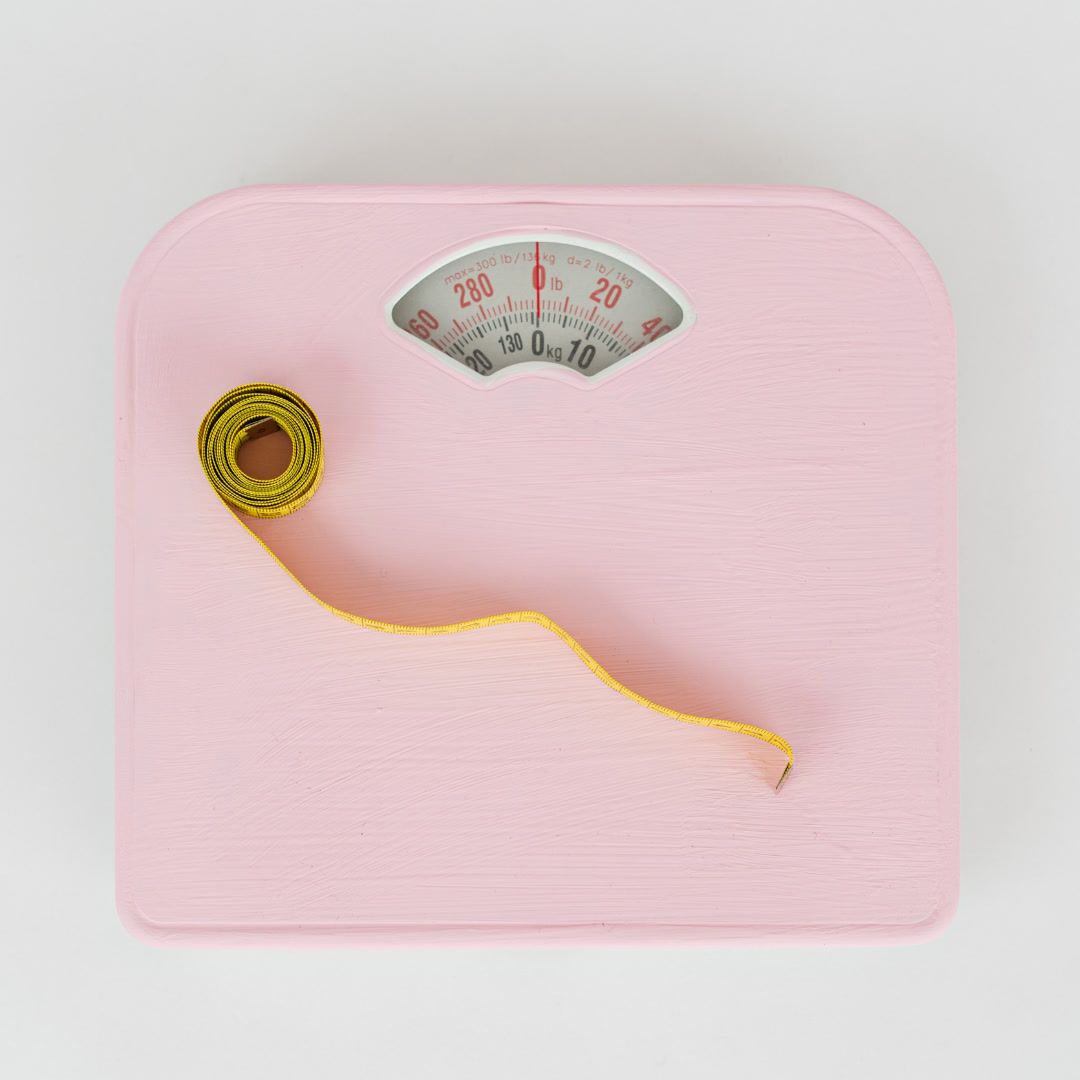The Best Time to Take Clomid for Men: A Guide

Understanding Clomid for Men: Complete Benefits, Side Effects, and Updated Dosage Guide
Medical Disclaimer: The content below is for informational purposes only and is not a substitute for professional medical advice, diagnosis, or treatment. Always seek the guidance of a qualified healthcare provider with any questions you may have regarding a medical condition or therapy.
Updated October 2025
Clomid® (clomiphene citrate) is best known as a women's fertility drug. Today, clinicians increasingly prescribe it off-label to men who want to boost testosterone and preserve sperm counts—without suppressing natural hormone production.
If you've heard about "off-label Clomid for men" and wondered whether it's hype or a clinically relevant option, this guide breaks down the science, real-world results, and practical dosing timelines.
Key takeaways
- Clomid stimulates your own testosterone production while preserving fertility—unlike TRT which typically suppresses sperm production
- Expect measurable hormone rises within 3–6 weeks, with most men seeing 200–300 ng/dL testosterone increases
- Routine lab monitoring (at 3, 6, and 12 weeks) ensures treatment safety and efficacy
- Side effects are usually mild and dose-dependent, but serious side effects require immediate medical attention
- Real-world data shows 58% of men with low sperm counts can avoid IUI/IVF when using Clomid appropriately
What Is Clomid?
Clomid, also known by its generic name clomiphene citrate, is a selective estrogen-receptor modulator (SERM) that was approved by the FDA in 1967 to trigger ovulation in women. It belongs to a class of medications that bind to estrogen receptors in the body and modulate their activity.
In men, it works differently than in women: by blocking estrogen receptors in the brain, it prompts the body to produce more luteinizing hormone (LH) and follicle-stimulating hormone (FSH)—key drivers of testosterone production and spermatogenesis.
Testosterone is an essential hormone for men, contributing to muscle mass, bone density, libido, and overall well-being. By stimulating the production of testosterone, Clomid can help restore hormonal balance in men with low testosterone levels.
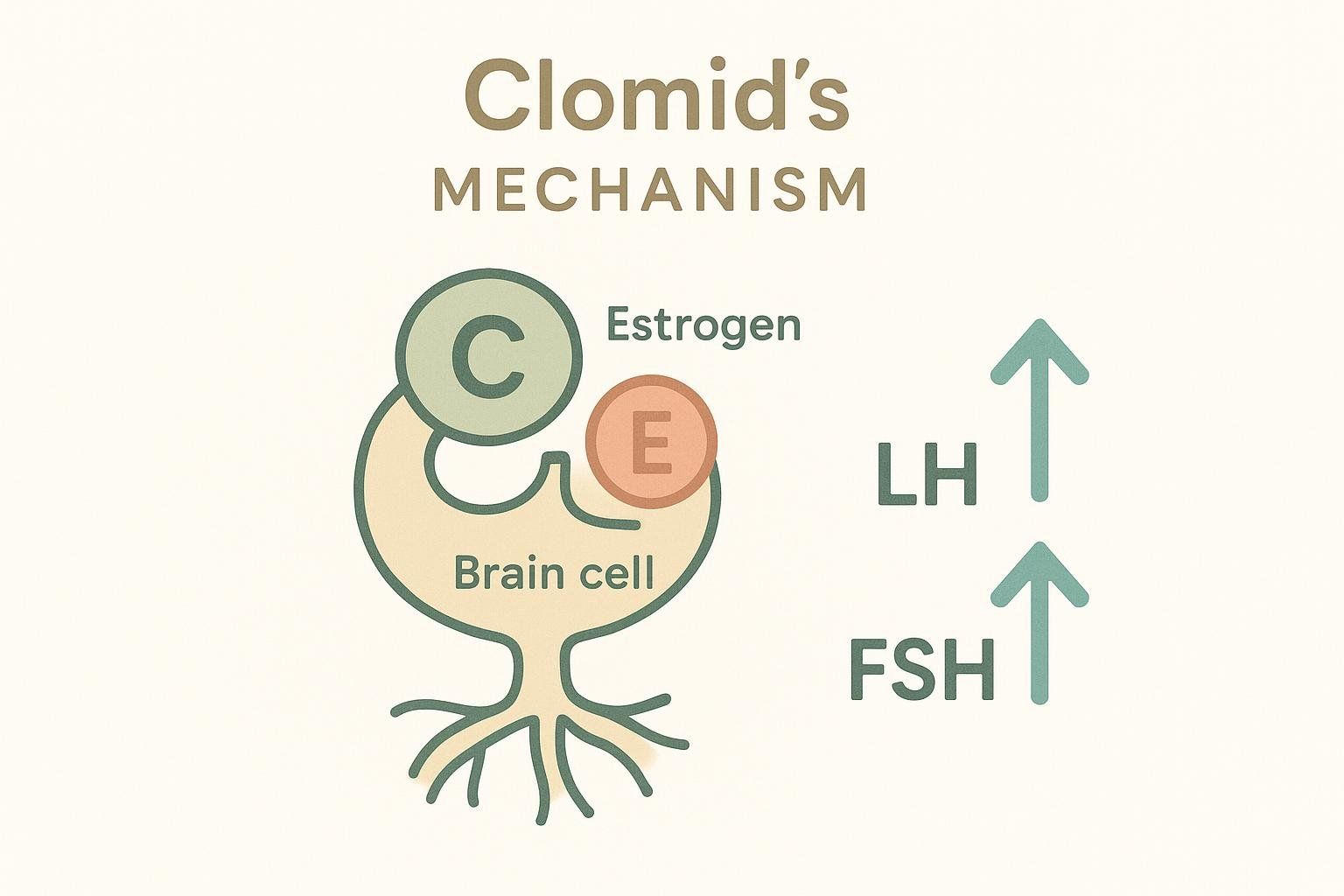
Understanding Low Testosterone
Before exploring Clomid as a treatment option, it's important to understand low testosterone itself and how it can affect your health and quality of life.
Symptoms of Low Testosterone
Low testosterone can manifest itself in a variety of ways, and recognizing these symptoms is the first step toward seeking appropriate treatment. Some common symptoms include:
- Persistent fatigue and low energy levels
- Decreased muscle mass and strength
- Reduced bone density, increasing fracture risk
- Increased body fat, particularly around the abdomen
- Erectile dysfunction and reduced libido
- Depressed mood, irritability, or difficulty concentrating
- Sleep disturbances
These symptoms can have a profound effect on a man's quality of life, making it difficult to engage in activities he once enjoyed and impacting personal relationships. Feeling constantly fatigued and lacking energy can make it challenging to perform daily tasks and can lead to decreased motivation to exercise or engage in physical activities. The loss of muscle mass and reduced bone density can increase the risk of fractures and injuries. Additionally, the accumulation of body fat can further contribute to a decrease in self-esteem and body image dissatisfaction.
Perhaps one of the most distressing symptoms of low testosterone is erectile dysfunction. This can significantly impact a man's sexual relationships and self-confidence, leading to feelings of inadequacy and frustration, and causing strain in intimate partnerships.
Causes of Low Testosterone
Several factors can contribute to low testosterone levels, and understanding the underlying cause is crucial for determining the most appropriate treatment approach:
Age-related decline: One of the most common causes is aging, as testosterone production naturally declines as a man gets older. This decline usually starts around the age of 30 and continues gradually throughout the years. However, some men may experience a more rapid decline, leading to low testosterone levels at a younger age.
Medical conditions: Certain health conditions can also contribute to low testosterone. Obesity, diabetes, and chronic illness have been linked to decreased testosterone production. These conditions can disrupt the normal hormonal balance in the body, leading to a decrease in testosterone levels.
Lifestyle factors: Excessive alcohol consumption and drug use, particularly anabolic steroids, can interfere with the body's natural hormone production. These substances can disrupt the delicate balance of hormones, leading to a decrease in testosterone levels.
Genetics: Some men may have a genetic predisposition that makes them more susceptible to low testosterone levels. This genetic factor can influence the body's ability to produce and regulate testosterone, leading to imbalances and deficiencies.
It's important to note that while these factors can contribute to low testosterone, each individual's situation is unique. Consulting with a healthcare professional is essential to determine the underlying cause of low testosterone and develop an appropriate treatment plan.
How Does Clomid Work in Male Bodies?
The hypothalamic–pituitary–gonadal (HPG) axis coordinates male reproductive hormones:
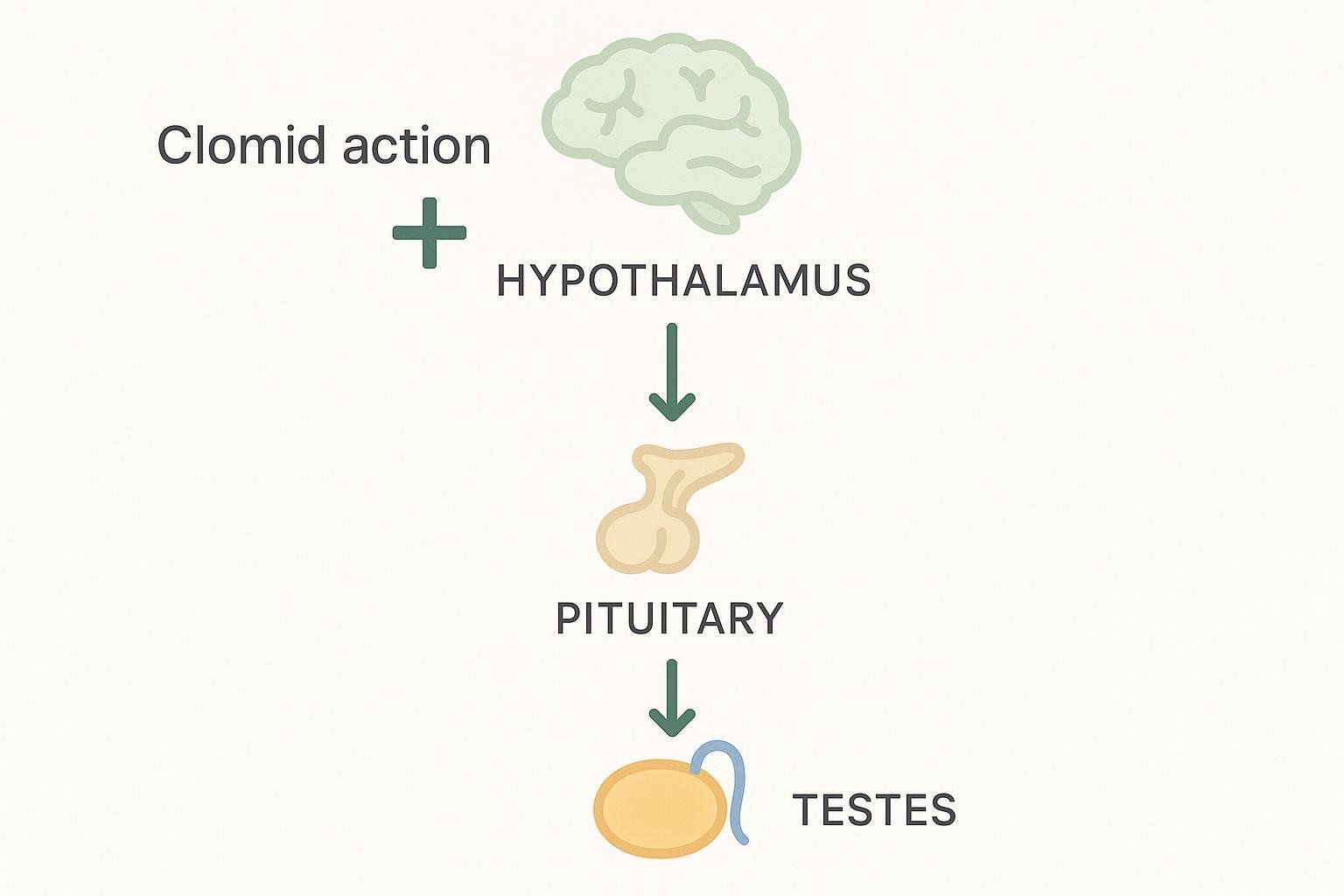
- The hypothalamus releases gonadotropin-releasing hormone (GnRH).
- The pituitary gland secretes LH and FSH.
- The testes use these signals to make testosterone and mature sperm.
Normally, circulating estrogen suppresses GnRH, limiting LH/FSH production. When Clomid is taken, it acts as an antagonist to estrogen receptors in the hypothalamus. By blocking these receptors, Clomid prevents the hypothalamus from detecting estrogen levels in the body. This lifts the brake on hormone production, signaling the pituitary gland to increase FSH and LH output, which in turn triggers the testes to produce more testosterone.
A 2022 meta-analysis of 1,279 men reported an average increase of 200–300 ng/dL in total testosterone—roughly a 50–100% jump from baseline—and parallel improvements in sperm concentration and motility (Huijben 2022). Narrative reviews confirm similar hormone and semen benefits (Wu 2024).
Why that matters:
- Preserves fertility – Unlike testosterone shots that suppress sperm production, Clomid maintains—or improves—semen parameters.
- Cost-effective – Generic clomiphene can be relatively inexpensive; GoodRx cash coupons list 30 × 50 mg tablets for about $76 (≈ $38/month at 25 mg/day) (GoodRx Clomiphene 2025).
- Reversible – Hormone levels generally return to baseline within weeks of stopping therapy.
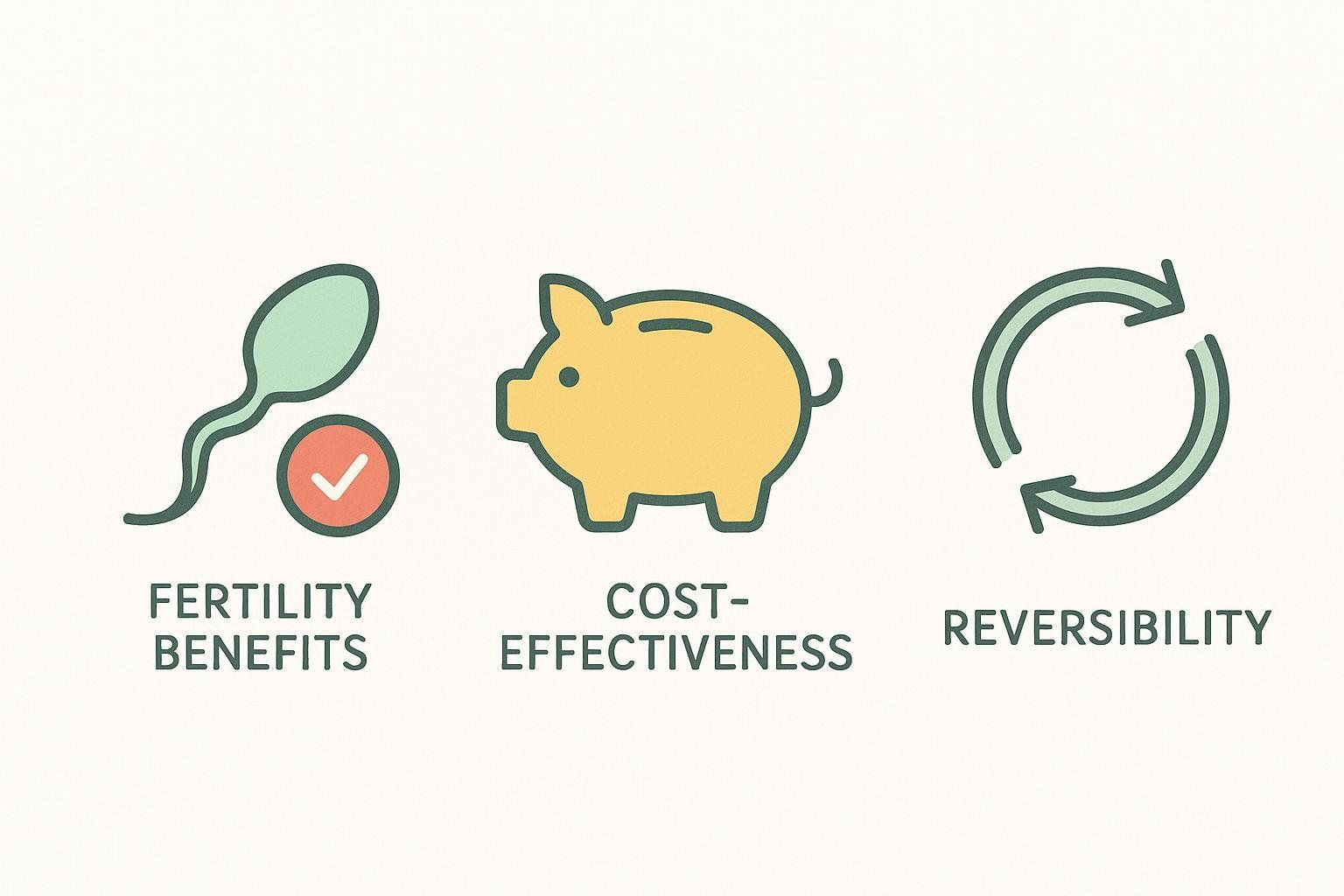
Why Doctors Prescribe Clomid Instead of Testosterone Shots
One of the most common questions men ask is why their doctor might recommend Clomid over traditional testosterone replacement therapy (TRT). The answer lies in how each treatment affects your body's natural hormone production and fertility.
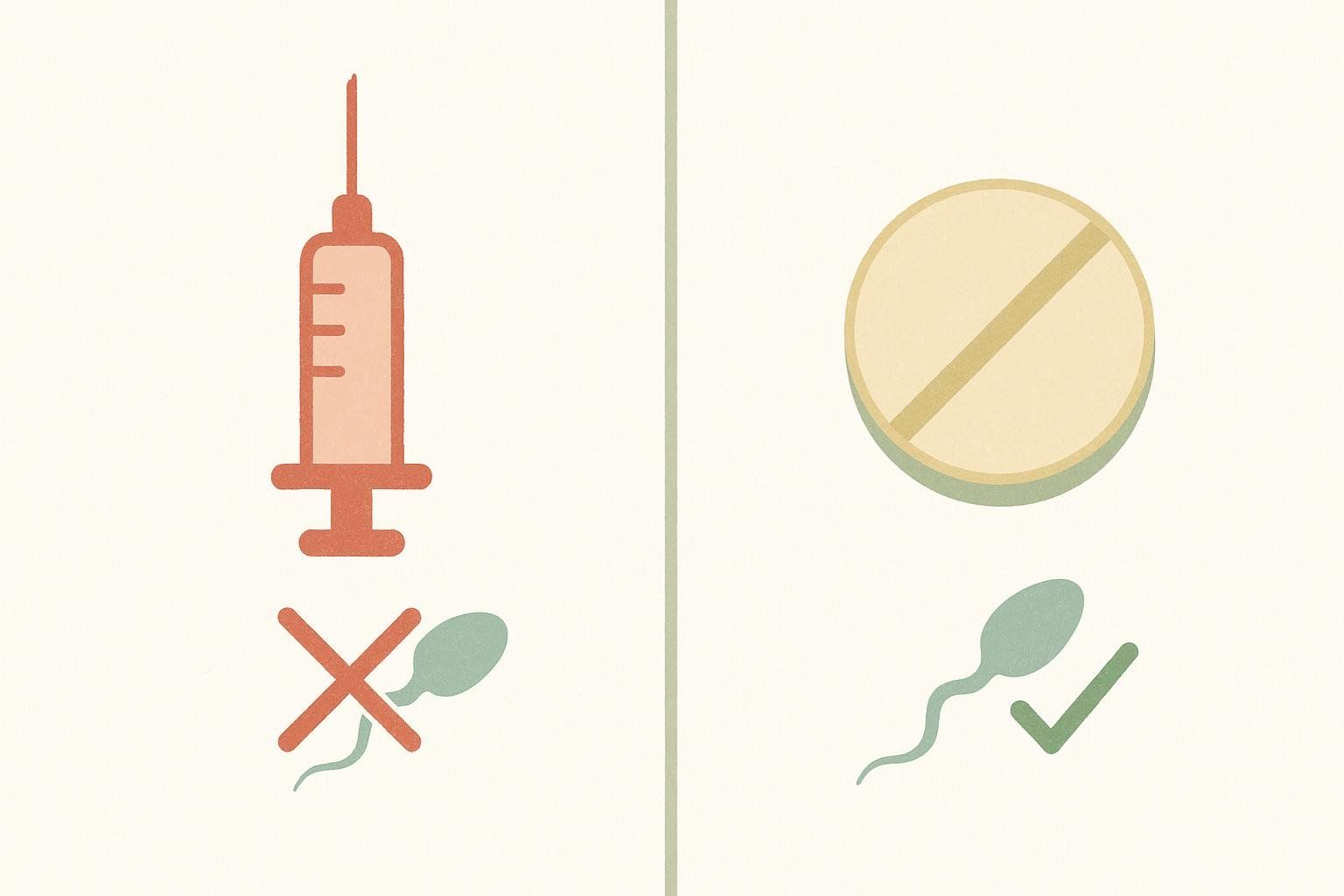
| Concern | Testosterone Replacement (TRT) | Clomid |
|---|---|---|
| Fertility | Suppresses sperm; may require hCG add-on | Usually preserves or boosts sperm |
| Blood thickness (hematocrit) | Can rise & increase cardiovascular risk | Much lower incidence |
| Administration | Injections, gels, pellets | Oral tablet |
| FDA status (male use) | Approved | Off-label but widely studied |
| Approx. monthly cost (cash)† | $40–$120 (100–200 mg weekly) | $30–$40 (25 mg daily) |
†Cost estimates use GoodRx coupon pricing accessed May 2025—Testosterone Cypionate 200 mg/mL vial ($14–$30 per mL) (GoodRx Testosterone 2025) and Clomiphene 50 mg tablets ($76/30 tabs) (GoodRx Clomiphene 2025). Individual pharmacy prices may vary.
For men who want to maintain fertility while addressing low testosterone, Clomid offers a significant advantage. By boosting testosterone levels through your body's own production pathways rather than introducing external testosterone, Clomid allows you to improve symptoms while keeping your reproductive system functioning normally.
Clomid vs. Enclomiphene vs. TRT
| Feature | Clomid | Enclomiphene | TRT (injectable) |
|---|---|---|---|
| Molecule type | Mixed isomers (en- & zu-) | Isolated en- isomer | Bio-identical testosterone |
| Primary goal | Raise LH/FSH & T | Similar—potentially fewer estrogenic effects | Direct T replacement |
| Typical dosing | 25 mg daily or 50 mg EOD | 12.5 mg daily (investigational) | 100–200 mg IM weekly |
| FDA status (male use) | Off-label | Investigational | Approved |
| Sperm impact | Neutral/positive | Neutral/positive | Negative |
| Symptom relief | 4–8 weeks | 4–8 weeks | 2–4 weeks |
EOD = Every Other Day; IM = Intramuscular
Want a deeper dive into enclomiphene? Read "Exploring Enclomiphene Citrate: A New Option for Hormonal Therapy."
Determining the Right Dosage of Clomid
The dosage of Clomid for men will vary depending on several factors, and it is crucial to consult with a healthcare professional to determine the appropriate dosage and duration of treatment. They will consider various factors to tailor the dosage to meet the specific needs of the individual.
Factors Influencing Clomid Dosage
Several factors come into play when determining the optimal dosage of Clomid for men. These may include:
- The underlying condition being treated
- The severity of the hormonal imbalances in men
- Individual medical history and overall health
- Age, weight, and body composition
- Any potential contraindications or side effects
- Current testosterone levels and treatment goals
Typical Dosage Range for Men
The typical dosage range of Clomid for men can vary widely depending on individual needs and treatment goals. In general, a starting dose of 25-50 mg per day is often recommended. However, the dosage may need to be adjusted over time based on the individual's response and testosterone levels. It is essential to follow the prescribed dosage and consult with a healthcare professional for guidance throughout the treatment.
Clomid Dosage Timeline & Monitoring Checklist
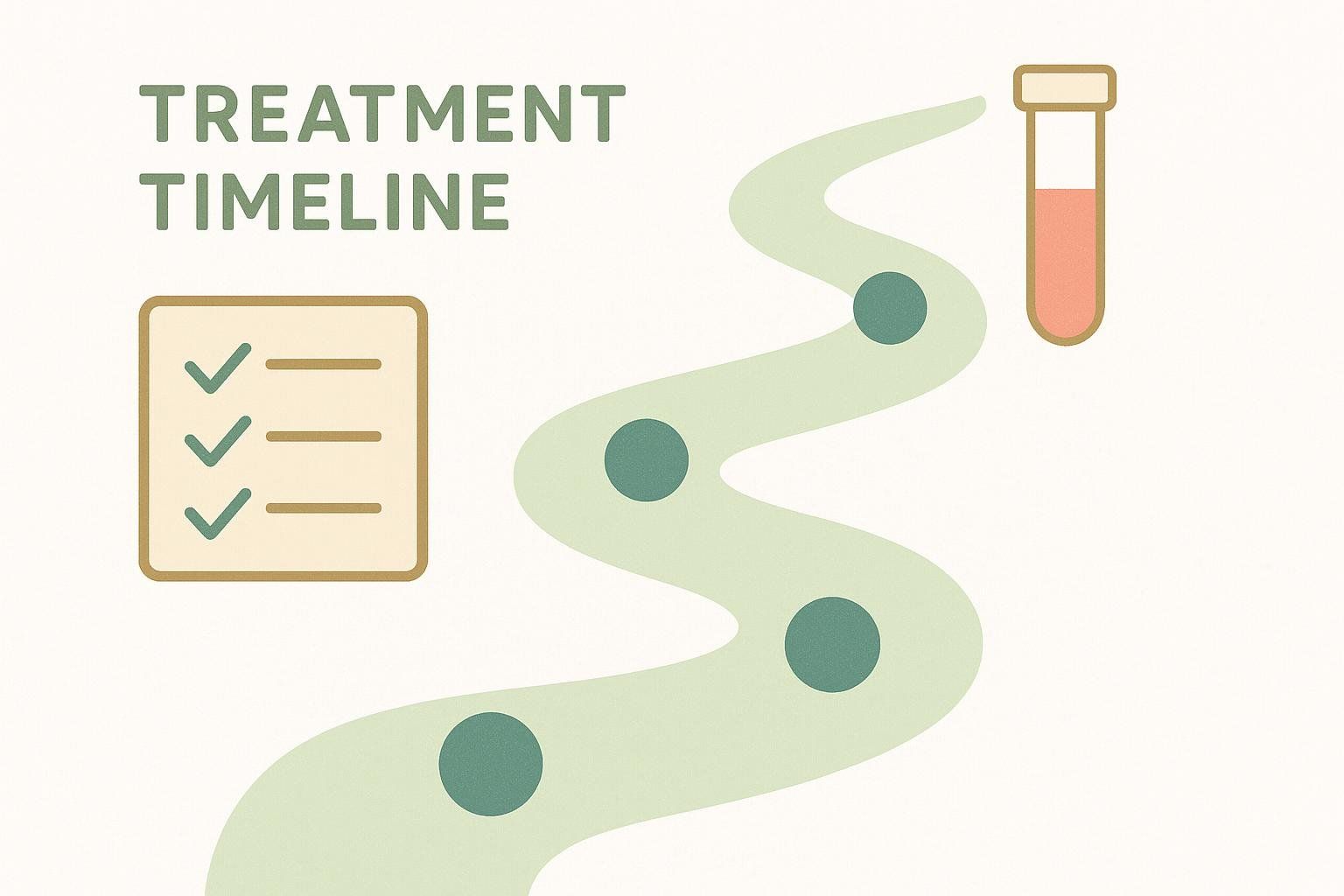
| Week | Common Dose | Key Labs to Check | Goal Range | Action If Off-Target |
|---|---|---|---|---|
| 0 | 25 mg daily (or 50 mg EOD) | Baseline Total Testosterone (TT), LH, FSH, Estradiol (E2), semen analysis | Establish Baseline | N/A |
| 3 | Continue same dose | TT & Free T | 400–900 ng/dL | Clinician may reduce to 25 mg EOD or otherwise adjust if TT > 900 ng/dL |
| 6 | Same | Complete Blood Count (CBC), E2 | Hematocrit < 52 %; E2 20–40 pg/mL | If E2 > 50 pg/mL → consider low-dose aromatase inhibitor |
| 12 | Same | TT, LH/FSH, semen | ↑ T ≥ 30 % & ↑ sperm | Clinician may uptitrate to 50 mg daily or add hCG if response is minimal |
| 24 | Re-assess | Full hormone panel + BodySpec DEXA | Maintain gains & monitor body composition | Clinician may suggest a pause ("drug holiday") every 6 months |
Based on monitoring results, dosage adjustments may be necessary to achieve the desired therapeutic effect. It is crucial to follow your healthcare professional's guidance and not make any dosage changes without proper medical supervision.
Tip: Schedule a BodySpec DEXA scan at baseline and again at 3–6 months to track changes in muscle, fat, and bone.
Expected Results: How Fast Will Testosterone or Sperm Improve?
- Testosterone: Many men see levels climb by week 3 and plateau around months 3–6 (Huijben 2022).
- Sperm parameters: Texas Fertility Center reported counts rising from 15 million/mL to 63 million/mL after ≈ 110 days on 25 mg/day, with 58% of oligospermic men avoiding IUI/IVF by conceiving spontaneously or with Clomid plus timed intercourse (TFC Austin 2023). This real-world success rate demonstrates that Clomid can be a valuable tool for improving fertility when used appropriately.
- Symptoms: Energy, libido, and mood often improve within 4–8 weeks, though individual responses can vary.
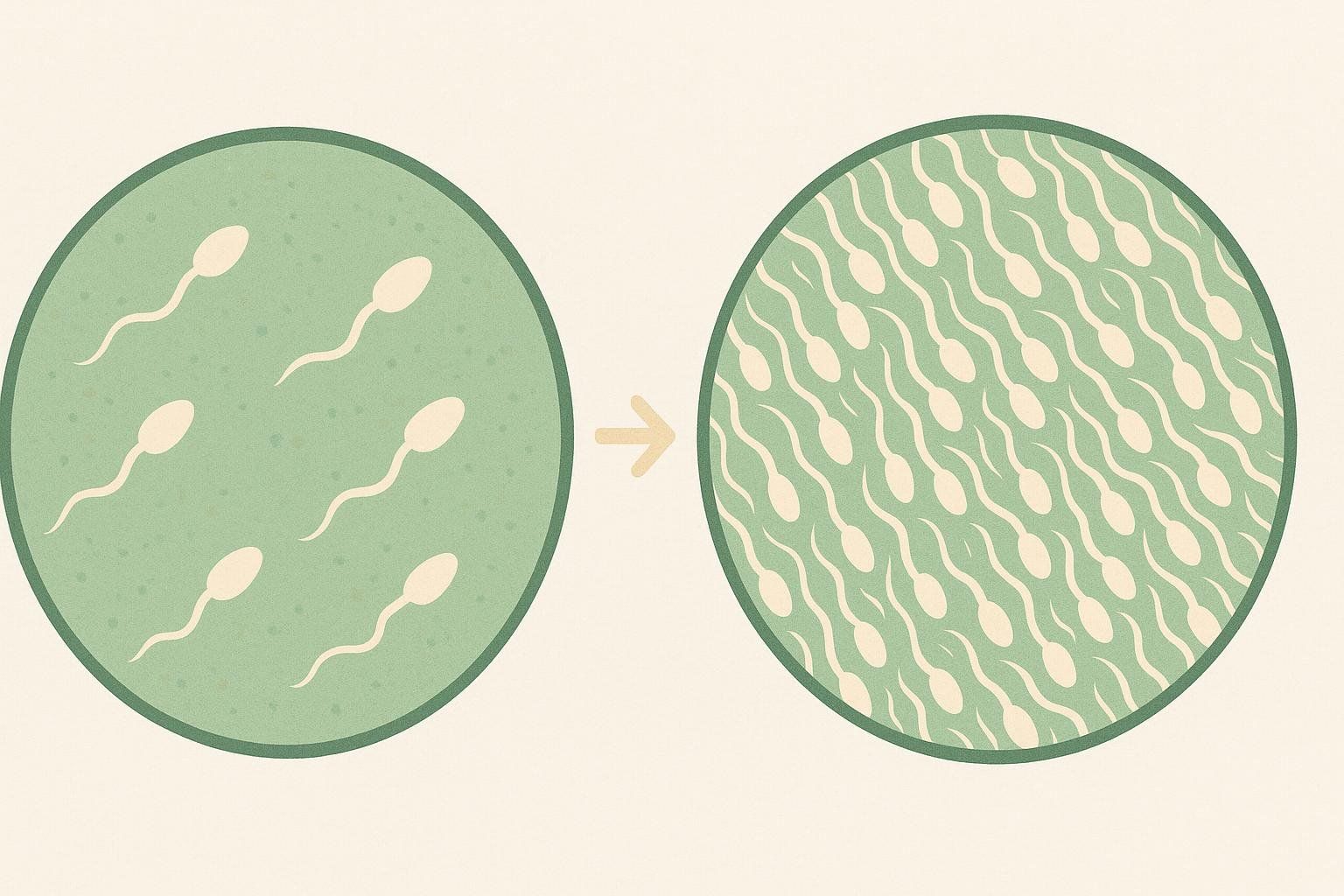
Common Side Effects of Clomid in Men and How to Minimize Them
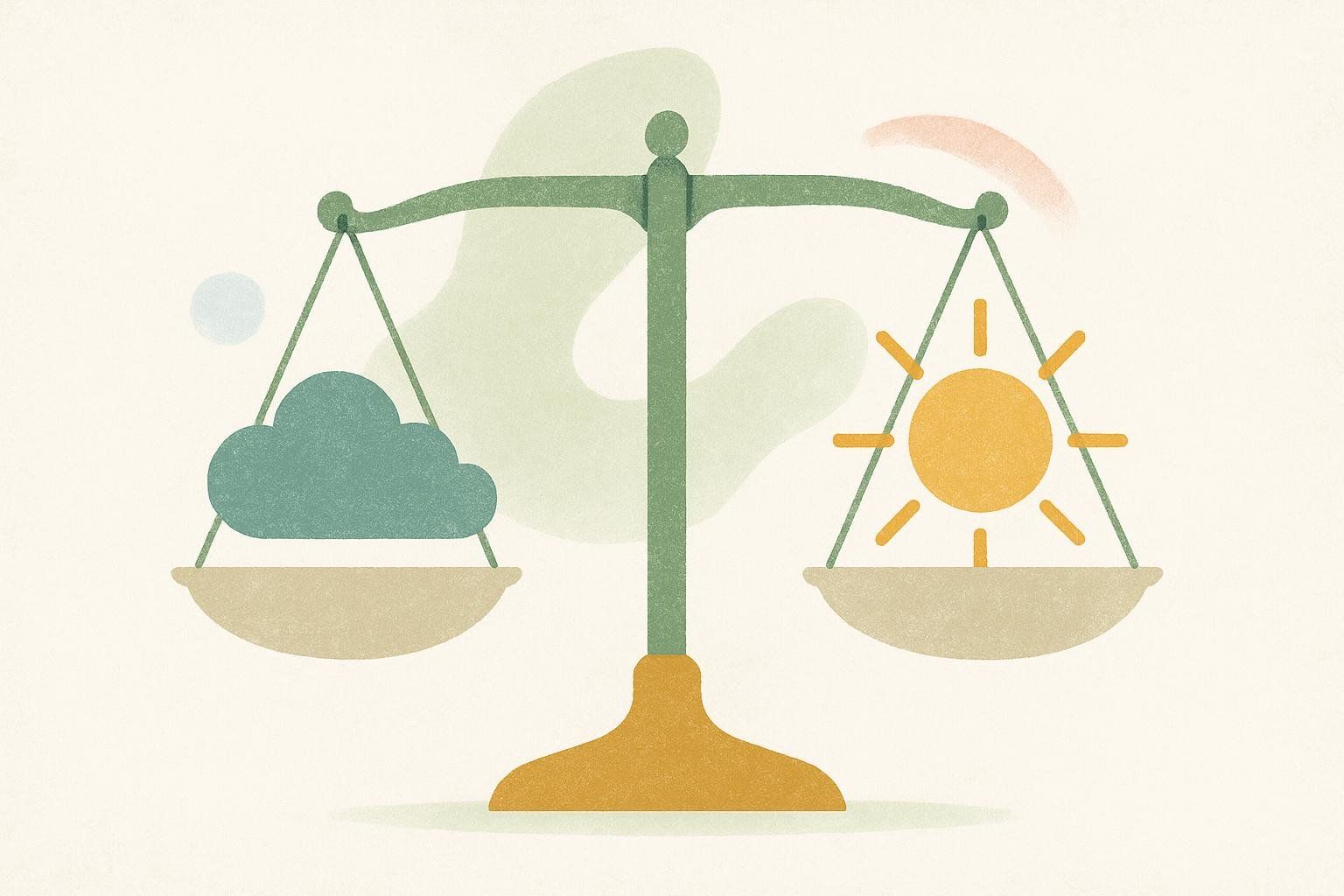
Like any medication, Clomid can have potential side effects, but they are generally well-tolerated by most men. It is important to be aware of these side effects and consult with a healthcare professional if they become bothersome or worrisome.
Common Side Effects
The most frequently reported side effects are generally mild and dose-dependent:
| Side Effect | Why It Happens | Mitigation |
|---|---|---|
| Headache / brain-fog | Shifting estrogen:T ratio | Split dose to morning; hydrate |
| Hot flashes | Hormonal fluctuations | Usually temporary; cool environment |
| Mood swings / irritability | Rapid hormone changes | Taper up slowly; stress-management techniques |
| Nausea | Gastrointestinal sensitivity | Take with food |
| Visual blurriness (rare) | Estrogen-receptor activity in retina | Discontinue & consult provider |
| Acne | Rising androgens | Standard skincare; zinc |
| Gynecomastia tenderness | Elevated E2 | Low-dose aromatase inhibitor (AI) under clinician guidance |
AI = Aromatase Inhibitor
These side effects are usually temporary and subside once the treatment is completed or as the body adapts to the medication. However, if any side effects persist or worsen, it is crucial to seek medical attention promptly.
Serious Side Effects
Although rare, there is a potential for more serious side effects associated with Clomid use. These may include:
- Allergic reactions
- Chest pain
- Breathing difficulties
- Vision changes or disturbances that do not resolve
If any of these symptoms occur, immediate medical attention should be sought.
Adverse events are often reported as mild and self-limiting (Huijben 2022; Moskovic 2012).
Who Should Not Use Clomid?
- Untreated pituitary tumors
- Primary testicular failure (non-responsive Leydig cells)
- Severe liver disease
- Uncontrolled high hematocrit (> 54 %)
- Vision disturbances on prior SERM use
- History of allergic reactions to clomiphene citrate
Always discuss your full medical history with a qualified clinician to identify any contraindications before starting treatment.
Natural Approaches and Alternative Treatments
While Clomid can be an effective treatment option for many men with low testosterone, it's not the only approach available. Some men may benefit from lifestyle modifications or may prefer to try natural methods before considering medication.
Natural Remedies for Low Testosterone
In some cases, making lifestyle changes can help increase testosterone levels naturally. These changes may include:
-
Maintaining a healthy weight: Regular exercise and a balanced diet can help optimize hormone production. Excess body fat, particularly visceral fat, is associated with lower testosterone levels.
-
Strength training: Resistance exercise has been shown to support healthy testosterone levels when combined with adequate recovery.
-
Quality sleep: Getting 7-9 hours of quality sleep per night is crucial for hormone regulation. Poor sleep is consistently associated with lower testosterone levels.
-
Stress management: Chronic stress elevates cortisol, which can interfere with testosterone production. Mindfulness practices, meditation, and adequate recovery time can help.
-
Limiting alcohol and avoiding smoking: Excessive alcohol consumption and smoking have both been linked to decreased testosterone production.
-
Optimizing nutrition: Ensuring adequate intake of zinc, vitamin D, and healthy fats supports hormone production.
When to Consider Medical Treatment
Natural approaches work best for men with borderline-low testosterone or those whose lifestyle factors are contributing significantly to their condition. However, medical treatment like Clomid may be more appropriate when:
- Testosterone levels are significantly below normal range
- Symptoms are severely impacting quality of life
- Natural interventions haven't produced adequate results after 3-6 months
- Fertility is a concern and time is a factor
- Underlying medical conditions are contributing to low testosterone
Other Medical Treatments Beyond Clomid
For men with severe testosterone deficiency or those who don't respond well to Clomid treatment, other medical interventions may be recommended:
-
Testosterone Replacement Therapy (TRT): Involves the administration of exogenous testosterone to normalize levels through injections, gels, patches, or pellets. While effective for symptom relief, TRT typically suppresses natural production and reduces fertility.
-
hCG (Human Chorionic Gonadotropin): Works similarly to LH to stimulate testosterone production while maintaining fertility. Sometimes used in combination with Clomid or as an alternative.
-
Enclomiphene: The isolated active isomer of Clomid, currently investigational but showing promise with potentially fewer side effects.
Your healthcare provider can help determine which treatment approach is best suited to your particular situation based on your symptoms, lab values, fertility goals, and overall health status.
Frequently Asked Questions
Is Clomid legal for men?
Yes. Physicians may prescribe it off-label when they judge the benefits outweigh the risks.
Can I combine Clomid and TRT?
Some doctors use "micro-TRT" plus low-dose Clomid or hCG to balance symptoms and fertility, but data are limited. Close monitoring is mandatory.
How long can I stay on Clomid?
Long-term cohort data show sustained testosterone normalization for up to 3 years with few serious side effects (Moskovic 2012). Many men cycle 3–6 months on, 1–3 months off under physician guidance.
Does Clomid grow muscle?
Indirectly. Higher testosterone improves protein synthesis, but resistance training and nutrition still do the heavy lifting. See "Gaining Lean Muscle: A Comprehensive Guide."
Clomid vs. enclomiphene—which has fewer side effects?
Early data suggest isolated enclomiphene may cause less estrogenic brain-fog, but head-to-head trials are ongoing.
Will my insurance cover it?
Sometimes, when prescribed for hypogonadism or infertility codes. Generics remain inexpensive even without coverage.
What happens if a dose is missed?
If a dose of Clomid is missed, it is generally recommended to take it as soon as you remember. However, if it is close to the time for the next scheduled dose, it is advisable to skip the missed dose and continue with the regular dosing schedule. Taking a double dose to make up for the missed one is not advised.
Can Clomid dosage be increased?
Yes, in some cases, the dosage of Clomid may need to be increased to achieve the desired therapeutic effect. This decision is typically based on the individual's response to treatment and the results of monitoring tests. However, any changes in dosage should be made under the guidance of a healthcare professional.
Tracking Your Progress with BodySpec
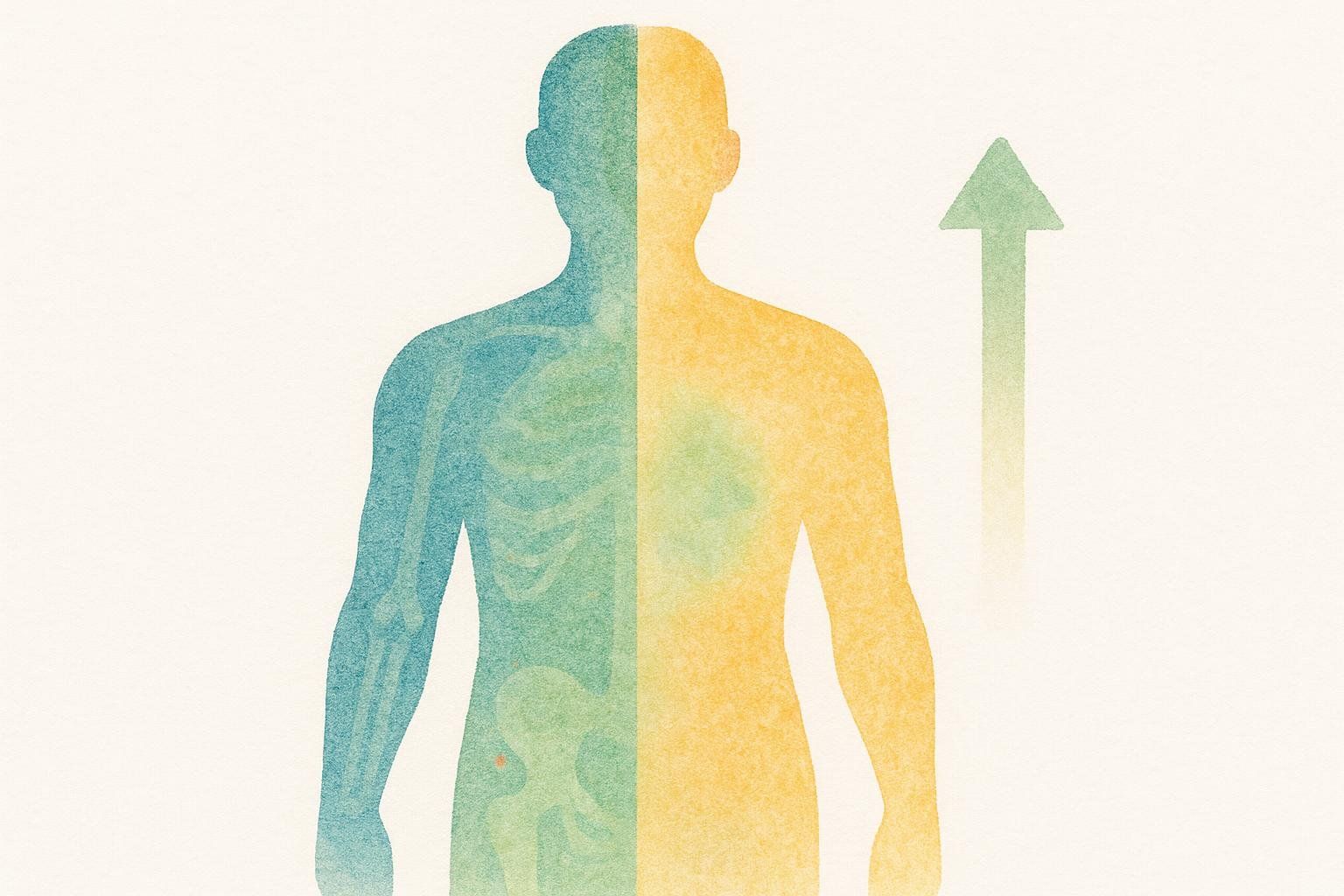
Hormone therapy affects more than a lab number—it reshapes muscle, fat, and bone density. A BodySpec DEXA scan provides granular data on:
- Visceral vs. subcutaneous fat (key for cardiometabolic risk)
- Lean-mass gains in arms, legs, and trunk
- Bone-density changes if testosterone normalizes
If you're interested in tracking your body composition and overall health, consider BodySpec's affordable DEXA scans. With DEXA scans, you can accurately measure your body fat, muscle mass, and bone health over time.
Book your baseline scan today and compare follow-ups to see exactly how your Clomid protocol is working.
Need more hormone-health insights? Read "Understanding Hormonal Health in Men: Testosterone and Beyond."
Key Takeaways
- Clomid stimulates your own testosterone production while preserving fertility.
- Expect measurable hormone rises within 3–6 weeks and sperm gains by 3 months.
- Routine lab tests monitor treatment safety and efficacy, while a BodySpec DEXA scan tracks changes in body composition and bone density.
- Side effects are usually mild and dose-dependent, but serious side effects require immediate medical attention.
- Work closely with a knowledgeable provider to tailor dose, monitoring, and cycle length based on individual factors including age, weight, and overall health.
Schedule your BodySpec scan now and track every milestone.
